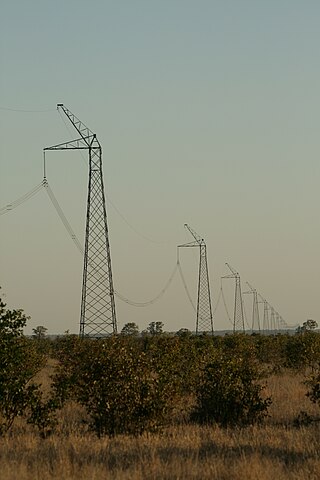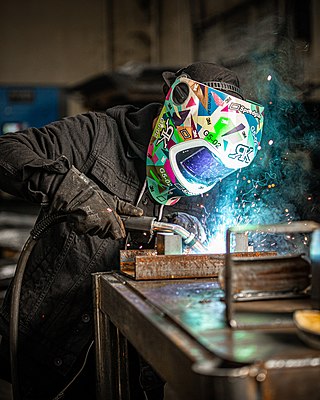
A Yablochkov candle (sometimes electric candle) is a type of electric carbon arc lamp, invented in 1876 by the Russian electrical engineer Pavel Yablochkov.

A Yablochkov candle (sometimes electric candle) is a type of electric carbon arc lamp, invented in 1876 by the Russian electrical engineer Pavel Yablochkov.
A Yablochkov candle consists of a sandwich of two electrodes, which are long carbon rods, approximately 6 by 12 millimetres in cross-section, separated by a block of inert and insulating material such as plaster of Paris or kaolin. There is a small piece of fuse wire or carbon paste linking the two carbon rods at the top end. The assembly is mounted vertically into a suitable insulated holder.
On application of the electric supply, the fuse wire "blows" and strikes the arc. The arc then continues to burn, gradually consuming the carbon electrodes and the intervening plaster, which melts at the same pace. The first candles were powered by a Gramme machine. The drawback of using direct current was that one of the rods would burn at twice the rate of the other. This problem was initially solved by preparing the sandwich with one of the rods thicker than the other, but this solution was not practicable. The problem was eventually solved by powering the candles with alternating current which burned the two rods at the same speed. [1]
The electrodes last about two hours or until the power is cut. A classic Yablochkov candle cannot be relit, since the fuse wire between the electrodes has been consumed. Later versions of the candle, however, included powdered metal in the inert separator. [2] This would act as a new fuse wire, allowing a half-burnt candle to be restarted once extinguished. The advantage of this design over other carbon arc designs is that it removes the need for a mechanical regulator to maintain the appropriate distance between the carbon electrodes to sustain the arc.
In his trials to power more sets of candles with different light flux and in order to obtain different voltages, Yablochkov invented the first transformers. [3]
As any other carbon arc lamps, Yablochkov candles have a very bright light that can be used for lighting large lengths of streets or large interiors such as factories and train stations and its use as a street lighting system was cheaper than oil lamps. [4] The disadvantages of these lamps are related to a short duration, which implied replacing them after short periods of time. When lit they produce buzzing noise, dangerous UV rays, carbon monoxide emissions and radio frequency interference. During use they were a constant fire hazard principally due to sparks and high operating temperature. [5]

In 1875 Yablochkov left Russia and started his Paris business; by 1876 he was granted the French patent 112024 for his candles. The first public experiment was held in London on April 15, 1876. [6] The Yablochkov candles were first used commercially in 1877 in the Marengo hall of the department store Galeries du Louvre in Paris with an installation of 80 lamps. Their presence is mentioned by Émile Zola in his novel Au Bonheur des dames (Ladies paradise). [1] In this occasion Paris was nicknamed city of lights. [6]
They were first demonstrated as street illumination during the Paris Exhibition of 1878, notably on the Avenue de l'Opéra, in Place du Theatre Français (now Place André Malraux) and in Place de l'Opéra. The 64 [7] lamps had four to twelve candles each, connected in series and were enclosed in globes of enamelled glass. [1] In December of the same year Yablochkov candles were installed along the Victoria Embankment in London. [8]
Werner von Siemens visited the 1878 Paris Exhibition and negotiated to become a distribution agent for the candles in Germany; in return he delivered dynamo machines to Yablochkov. [9] The candles were soon used in many European cities but also in other continents: cities such as Rio de Janeiro, Mexico City, New Delhi, Calcutta, and Madras were using them. The Shah of Persia and the King of Cambodia used the candles for their palaces. [6]
The candles were successfully used aboard the French ironclad Amiral Duperré, launched in 1879. [10]
In 1881 at the International Exposition of Electricity the Yablochkov candles were regarded as one of the main attractions. At that time their cost was estimated to have dropped from 66 cents (of French francs) in 1877 to just 10 cents, making them very convenient also with respect to gas lamps. The main drawback was that the candles needed a big power machine in order to be lit. [10]
At the height of their success 8,000 candles per day were produced in France. [6]


An electric light, lamp, or light bulb is an electrical component that produces light. It is the most common form of artificial lighting. Lamps usually have a base made of ceramic, metal, glass, or plastic, which secures the lamp in the socket of a light fixture, which is often called a "lamp" as well. The electrical connection to the socket may be made with a screw-thread base, two metal pins, two metal caps or a bayonet mount.

An incandescent light bulb, incandescent lamp or incandescent light globe is an electric light with a filament that is heated until it glows. The filament is enclosed in a glass bulb that is either evacuated or filled with inert gas to protect the filament from oxidation. Electric current is supplied to the filament by terminals or wires embedded in the glass. A bulb socket provides mechanical support and electrical connections.

Artificial lighting technology began to be developed tens of thousands of years ago and continues to be refined in the present day.

An arc lamp or arc light is a lamp that produces light by an electric arc.

Single-wire earth return (SWER) or single-wire ground return is a single-wire transmission line which supplies single-phase electric power from an electrical grid to remote areas at lowest cost. Its distinguishing feature is that the earth is used as the return path for the current, to avoid the need for a second wire to act as a return path.

The Exposition Universelle of 1878, better known in English as the 1878 Paris Exposition, was a world's fair held in Paris, France, from 1 May to 10 November 1878, to celebrate the recovery of France after the 1870–71 Franco-Prussian War. It was the third of ten major expositions held in the city between 1855 and 1937.

Arc welding is a welding process that is used to join metal to metal by using electricity to create enough heat to melt metal, and the melted metals, when cool, result in a binding of the metals. It is a type of welding that uses a welding power supply to create an electric arc between a metal stick ("electrode") and the base material to melt the metals at the point of contact. Arc welding power supplies can deliver either direct (DC) or alternating (AC) current to the work, while consumable or non-consumable electrodes are used.

Pavel Nikolayevich Yablochkov was a Russian electrical engineer, businessman and the inventor of the Yablochkov candle and the transformer.
Electrification is the process of powering by electricity and, in many contexts, the introduction of such power by changing over from an earlier power source.

A street light, light pole, lamp pole, lamppost, street lamp, light standard, or lamp standard is a raised source of light on the edge of a road or path. Similar lights may be found on a railway platform. When urban electric power distribution became ubiquitous in developed countries in the 20th century, lights for urban streets followed, or sometimes led.

An electric arc is an electrical breakdown of a gas that produces a prolonged electrical discharge. The current through a normally nonconductive medium such as air produces a plasma, which may produce visible light. An arc discharge is initiated either by thermionic emission or by field emission. After initiation, the arc relies on thermionic emission of electrons from the electrodes supporting the arc. An arc discharge is characterized by a lower voltage than a glow discharge. An archaic term is voltaic arc, as used in the phrase "voltaic arc lamp".

Gas tungsten arc welding is an arc welding process that uses a non-consumable tungsten electrode to produce the weld. The weld area and electrode are protected from oxidation or other atmospheric contamination by an inert shielding gas. A filler metal is normally used, though some welds, known as 'autogenous welds', or 'fusion welds' do not require it. A constant-current welding power supply produces electrical energy, which is conducted across the arc through a column of highly ionized gas and metal vapors known as a plasma.

Gas-discharge lamps are a family of artificial light sources that generate light by sending an electric discharge through an ionized gas, a plasma.

The Lizard Lighthouse is a lighthouse at Lizard Point, Cornwall, England, built to guide vessels passing through the English Channel. It was often the welcoming beacon to persons returning to England, where on a clear night, the reflected light could be seen 100 mi (160 km) away.
Electric power transmission, the tools and means of moving electricity far from where it is generated, date back to the late 19th century. They include the movement of electricity in bulk and the delivery of electricity to individual customers ("distribution"). In the beginning, the two terms were used interchangeably.

Nikolay Gavrilovich Slavyanov was an inventor from the Russian Empire who in 1888 introduced arc welding with consumable metal electrodes, or shielded metal arc welding, the second historical arc welding method after carbon arc welding invented earlier by Nikolay Benardos.

Holborn Viaduct power station, named the Edison Electric Light Station, was the world's first coal-fired power station generating electricity for public use. It was built at number 57 Holborn Viaduct in central London, by Thomas Edison's Edison Electric Light Company.

Firecracker welding is a rarely used form of shielded metal arc welding (SMAW).

Gas metal arc welding (GMAW), sometimes referred to by its subtypes metal inert gas (MIG) and metal active gas (MAG) is a welding process in which an electric arc forms between a consumable MIG wire electrode and the workpiece metal(s), which heats the workpiece metal(s), causing them to fuse. Along with the wire electrode, a shielding gas feeds through the welding gun, which shields the process from atmospheric contamination.